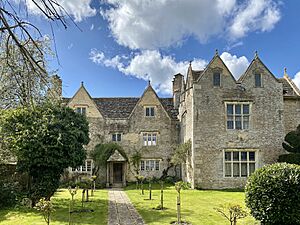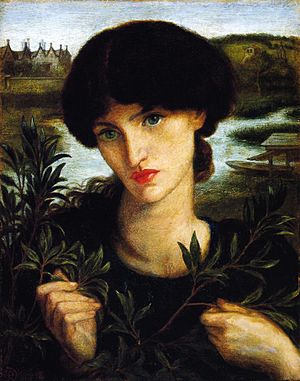Kelmscott Manor facts for kids
Quick facts for kids Kelmscott Manor |
|
|---|---|

Kelmscott Manor
|
|
| Type | Manor House |
| Location | Kelmscott |
| OS grid reference | SU 25096 98888 |
| Area | West Oxfordshire |
| Built | 1570 |
| Owner | Society of Antiquaries of London |
|
Listed Building – Grade I
|
|
| Official name: Kelmscott Manor | |
| Designated | 12 September 1955 |
| Reference no. | 1199373 |
|
Listed Building – Grade II
|
|
| Official name: Garden wall, attached summerhouse and privy at Kelmscott Manor | |
| Designated | 30 Mar 1989 |
| Reference no. | 1053381 |
| Lua error in Module:Location_map at line 420: attempt to index field 'wikibase' (a nil value). | |
Kelmscott Manor is an old stone house in the village of Kelmscott, England. It is located in West Oxfordshire, a beautiful area known as the Cotswolds. The house was built around 1570. A part of it was added later in the late 1600s. It is a very important historic building, listed as Grade I. This means it is protected because of its special history and architecture. The house is also very close to the River Thames. The nearest town is Lechlade-On-Thames.
Contents
History of Kelmscott Manor
Early Years: 1570 to 1870
A local farmer named Thomas Turner built Kelmscott Manor. His family owned the house for many years. After George Turner passed away in 1734, the house was rented out to others.
The house was first called Lower House. It became Kelmscott Manor in 1864. This was when James Turner bought the house and a large amount of land. After James died in 1870, his nephew, Charles Hobbs, took over. He continued to rent out the property.
William Morris and His Family
William Morris's Connection to the Manor
Kelmscott Manor became the country home of William Morris in 1871. Morris was a famous writer, designer, and a supporter of social change. He lived there until he died in 1896. Today, the Society of Antiquaries of London owns the manor. You can visit it on Thursdays, Fridays, and Saturdays during the summer.
Morris loved the house's original style and how it fit with its garden. He found a lot of ideas for his work from the manor. Kelmscott Manor is even shown in his book News from Nowhere. It also appears in the background of Water Willow. This is a painting of his wife, Jane Morris, by Dante Gabriel Rossetti.
The Morris Family After William
After William Morris died in 1896, his wife, Jane Morris, continued to live at the manor. She bought the house in 1913. Later, their daughters, Jenny and May, lived there. Jenny died in 1935, and May died in 1938.
May Morris left the house to Oxford University. She wanted the university to keep all the items inside and let people visit. However, the university did not want to keep the house as a museum. So, in 1962, they gave the house and land to the Society of Antiquaries.
Kelmscott Manor During Wartime
The first people to live in the manor after the Morris family were artists. They were Edward and Stephanie Scott-Godwin. They were friends with May Morris. They lived there from 1940 to 1948. During this time, they wrote a book about William Morris. This period was important for the house. It was a time of change between being a family home and becoming a place for visitors.
Kelmscott Manor Today
Restoration and Features
When the Society of Antiquaries received the manor, it was in poor condition. Much work was done in the 1960s to stop it from falling apart. Many of the main roof beams were rotten and needed to be replaced. The inside walls and floors were made stronger. A new porch was added to the North entrance. In the 1970s, the Society bought the barns next to the house. They turned them into a shop and a tearoom for visitors.
The inside of the manor today looks much like it did when William Morris lived there. You can see many of his famous textile patterns. There is also a lot of his furniture. Visitors can explore all three floors, including the attic. Farm workers used to live in the attic spaces. Morris's bedroom has many of his original books. It also has a collection of prints by Dürer. Other rooms show furniture from his other homes. You can also see art by Rossetti, Sir Edward Burne-Jones, and Pieter Brueghel the Younger.
Recent Renovations
Kelmscott Manor reopened in April 2022. This was after a big restoration project by the Society. The work cost £6 million. This money came from the National Lottery Heritage Fund and the Kelmscott: Past Present and Future campaign. A lot of work was done to the house's structure. The inside was also renovated. The manor is still a Grade I listed building.
The Gardens of Kelmscott Manor
The garden at Kelmscott Manor has many old trees. There is a very old black mulberry tree behind the house. The front garden has a wall around it. There is also a summer house in one corner. Both the wall and the summerhouse are listed as Grade II historic structures. The front garden has many rose bushes. Part of the original orchard was removed to make a small car park. However, many fruit trees are still there.
William Morris loved Kelmscott so much that he named his London home "Kelmscott House". He also named his printing business "the Kelmscott Press" after the manor. He is buried in the village churchyard. His friend, Philip Webb, designed his tomb.
See also
- Arts and Crafts movement
- Fasnacloich, a country house in Harrisville, New Hampshire said to be based on Kelmscott Manor



